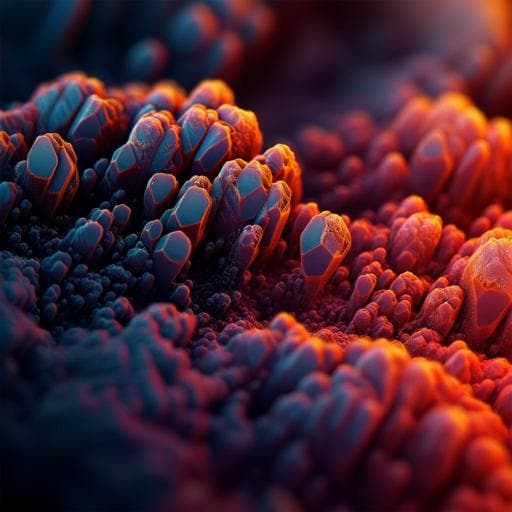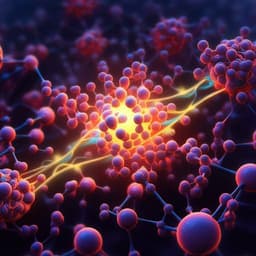
Medicine and Health
Boosting inhibition performance of natural polyphenols for the prevention of calcium oxalate kidney stones through synergistic cooperativity
S. Li, D. Zhou, et al.
This innovative research by Si Li, Donghui Zhou, Zuoxuan Zhu, Xiaoyue Tan, Weiwei Tang, and Junbo Gong uncovers a remarkable synergy in using crystal growth modifiers to thwart kidney stone formation. By mixing citrate with natural polyphenols, the team achieved a significantly enhanced inhibitory effect, suggesting a promising new strategy for kidney stone prevention.
~3 min • Beginner • English
Introduction
Pathological biomineralization such as calcium oxalate (CaOx) crystallization underlies kidney stone disease affecting ~10% of the population. Calcium oxalate monohydrate (COM) is the most stable and prevalent stone phase. While surgical management alleviates acute symptoms, recurrence rates exceed 50% within 5–10 years, motivating long-term medical strategies that reduce urinary supersaturation and crystal-cell interactions. Citrate is a known urinary inhibitor of COM growth and adhesion, and other modifiers (e.g., polyphosphates, proteins, metal ions) have been explored. However, single inhibitors often require high concentrations with potential toxicity. Drug combinations can enhance efficacy at lower doses, yet combinations of crystal growth inhibitors can yield synergistic, additive, or antagonistic effects, and the mechanisms of cooperativity remain unclear. This study investigates whether pairing citrate with natural polyphenols that act as step pinners and/or kink blockers can synergistically suppress COM crystallization and crystal-cell adhesion, and elucidates the underlying mechanisms.
Literature Review
Prior studies established COM growth via spiral mechanisms with solute incorporation, and molecular modifiers impede growth via step pinning (reducing local supersaturation by increasing step curvature) and/or kink blocking (reducing kinetic incorporation at kink sites). Citrate exhibits dual action (step pinning and kink blocking); hydroxycitrate can induce strain-mediated dissolution. Peptides such as (DDDS)3DDD act as step pinners, whereas (DDDG)3DDD are kink blockers. Natural polyphenols have been identified as COM growth inhibitors with roles spanning step pinning and kink blocking. Previous combination studies showed both synergy (e.g., citrate with chondroitin sulfate) and strong antagonism among some inhibitor pairs. However, cooperative actions between modifiers targeting the same crystalline substrate, and their implications for cell adhesion and in vivo outcomes, have been insufficiently understood.
Methodology
Bulk crystallization assays: Crystallization was performed at pH 6.4 ± 0.4 in 25 mL solutions (0.56 mM CaCl2, 0.56 mM Na2C2O4, 150 mM NaCl, with inhibitors) at 37 °C for 3 days, quiescent. A coverslip collected crystals for SEM. Binary ratios were CA/EA 1:0.007, CA/PGA 1:0.17, CA/GaA 1:0.025, CA/PrA 1:2.73; inhibitor concentrations relative to CA spanned 0–0.18 mM.
Growth kinetics by ion-selective electrode (ISE): Free Ca2+ depletion was tracked in 100 mL growth solutions (0.31 mM CaCl2, 0.31 mM Na2C2O4, 150 mM NaCl, inhibitors with the same ratios, 0–0.45 mM relative to CA) stirred at 400 rpm, with ~5 mg COM seeds. Inhibition percentage was computed from slopes relative to control.
Crystal seed preparation: COM (100) basal faces were grown from 0.56 mM CaCl2, 0.56 mM Na2C2O4, 150 mM NaCl; COM predominantly exposing (010) from the same plus 2.02 mM NaHCO3; 3 days at 37 °C.
In situ AFM: Step dynamics on COM surfaces were imaged (Dimension Icon, Peakforce tapping, Scanasyst fluid+ probes) in growth solutions at pH 6.4 ± 0.2 (0.31 mM CaCl2, 0.31 mM Na2C2O4, 150 mM NaCl, inhibitors), refreshed every 10 min. Supersaturation S ≈ 2.4 for control. Step velocities v were measured along (001), (021), and (121) step planes; v/v0 relative to control was reported. At least 15–25 measurements per condition.
Modeling: Analytical models were developed for cooperative inhibition by step pinning and kink blocking (extensions of Weaver and Vekilov frameworks) to relate v/v0 to CA and polyphenol concentrations, using parameters fitted from single-inhibitor AFM data. Isobolograms and 3D response surfaces v/v0 = f(CCA, Cpolyphenol) quantified synergy.
Cell experiments: HK-2 human proximal tubular cells were cultured in DMEM/F12 with 10% FBS and 1% pen/strep at 37 °C/5% CO2. Cells were exposed to 100 µg/mL COM crystals for 24 h with inhibitors: 200 µM CA alone or combinations (200 µM CA + 20 µM EA; 200 µM CA + 20 µM GaA; 200 µM CA + 40 µM PGA; 200 µM CA + 200 µM PrA). Viability was assessed by Calcein/PI staining and LDH release (490 nm). Crystal adhesion assays quantified adhered COM crystals after 30 min exposure with inhibitors; cells were washed and imaged; at least 10 random fields per well.
Animal studies: Male C57BL/6 mice (8 weeks, 18–22 g), n = 5 per group, received intraperitoneal glyoxylate (75 mg/kg/day) for 6 days to induce renal CaOx crystallization. Treatments included: vehicle control; Gly only; Gly + CA (50 mg/kg/day); and Gly + CA plus polyphenol combinations totaling 50 mg/kg/day with ratios: GaA:CA = 0.8:10, EA:CA = 1.4:10, PGA:CA = 1.2:10, PrA:CA = 7.3:10. On day 7, kidneys and serum were collected. CaOx deposition was assessed by polarized light microscopy and Von-Kossa staining; kidney injury by PAS staining with a 0–10 tubular injury score; kidney function by serum creatinine and BUN kits. Statistics: one-way ANOVA and two-tailed Student’s t-tests; estimation graphics (DABEST) for animal data.
Key Findings
- Binary combinations of citrate (CA) with natural polyphenols (EA, GaA, PGA, PrA) enhanced inhibition of COM crystallization up to four-fold compared with CA alone.
- SEM and aspect ratio analyses showed CA/polyphenol pairs produced combined morphological effects and reduced [001]/[010] aspect ratios more than single inhibitors; CA/GaA and CA/PGA showed the most pronounced aspect ratio decreases.
- ISE growth kinetics: All CA/polyphenol pairs outperformed CA alone. Notably, pairing potent (CA) with weaker (PGA) yielded suppression comparable to potent-pair combinations. CA/PrA showed modest synergy at low CA concentrations.
- Combination index (CI) analyses indicated strong synergism (CI < 1) for all four CA/polyphenol pairs; CA/GaA and CA/PGA exhibited CI values about one-third of the previously reported strongest CA–C4S pair, evidencing superior cooperative efficacy.
- AFM step kinetics: Binary pairs significantly reduced step velocities v/v0 along (001), (021), and (121) compared with CA alone. PrA alone reduced v along (001) by up to ~50% at 0.26 mM, whereas in combination with CA achieved ~72% inhibition at ~0.034 mM, demonstrating strong synergy. Isobolograms confirmed leftward shifts for all pairs (CA/GaA, CA/PGA, CA/PrA, CA/EA), indicating synergism at 10–70% inhibition levels.
- Modeling captured the synergistic reduction in v/v0 for CA/PGA, CA/EA, CA/GaA, and broadly for CA/PrA, attributing synergy to parallel depression of crystallization driving force (step pinning) and reduction of kinetic constants (kink blocking).
- Cell assays: Exposure to COM crystals raised LDH release to 277.14% ± 36.02% of control; CA reduced this to 195.17% ± 2.46%. Combinations further reduced LDH: CA/GaA 110.87% ± 8.67%, CA/PrA 115.73% ± 3.32%, outperforming other pairs. CA reduced crystal adhesion by ~30%, whereas CA/polyphenol pairs reduced adhered crystals by ~50%. Viability improvements were synergistic, with CA/GaA and CA/PrA strongest for LDH/viability; CA/EA most effective in reducing adhesion.
- In vivo mouse model: All treatment groups reduced renal CaOx deposition versus Gly-only; CA/polyphenol pairs showed synergistic reductions. CA/PGA exhibited strong synergy; CA/EA yielded the greatest reduction in crystal deposition. Kidney injury scores improved with combinations (CA/GaA, CA/PGA, and CA/EA superior to CA alone). BUN and serum creatinine improved with combinations consistent with reduced injury.
- Pharmacokinetic considerations: The in vivo efficacy differences (e.g., lower CA/GaA performance relative to in vitro) align with GaA urinary recovery of ~36.4% of ingested dose; CA/PrA showed limited efficacy, potentially due to poor absorption.
Discussion
The study demonstrates that pairing citrate with natural polyphenols targeting the same COM crystal surfaces produces robust synergistic inhibition of crystal growth and crystal-cell interactions. Synergy arises from concurrent decreases in growth kinetic constants (via kink site blockage) and suppression of the crystallization driving force (via increased step curvature from step pinning). This cooperative mechanism is validated by AFM step velocity measurements, isobologram analyses, and theoretical models extending established frameworks. Importantly, enhanced inhibition occurs even when combining a dual-acting inhibitor (citrate) with a weaker partner (e.g., PGA), outperforming some potent–potent pairings. The improved suppression of crystal adhesion and cytotoxicity in HK-2 cells, and reduced renal CaOx deposition and injury in vivo, indicate translational potential for combination therapies to prevent kidney stones at lower doses than single-agent therapies. Differences between in vitro and in vivo efficacies among pairs reflect pharmacokinetics and bioavailability of polyphenols, emphasizing the need to consider metabolism and delivery.
Conclusion
Binary combinations of citrate with natural polyphenols (gallic, ellagic, pyrogallic, protocatechuic acids) yield strong synergistic suppression of COM crystallization and crystal-cell adhesion. Synergy stems from combined step pinning and kink blocking mechanisms that reduce crystallization driving force and growth kinetics. Efficacy is evidenced across bulk crystallization, AFM step kinetics, cell viability and adhesion assays, and an in vivo nephrocalcinosis mouse model, with CA/GaA, CA/PGA, and CA/EA particularly effective. These findings support developing low-dose combination formulations to prevent calcium oxalate kidney stones. Future research should optimize dosing ratios and delivery routes (e.g., oral formulations), evaluate pharmacokinetics and metabolism for each polyphenol, expand to longer-term and larger animal studies, assess safety and toxicity, and explore additional synergistic modifier pairs and mechanisms beyond step pinning/kink blocking.
Limitations
Model predictions deviated from experimental step velocity data at higher inhibitor concentrations for some pairs (CA/EA, CA/GaA, CA/PrA), potentially due to effects not captured by step pinning or kink blocking, such as surface solvation and local strain. In vivo outcomes varied among combinations, influenced by pharmacokinetics and bioavailability (e.g., only ~36.4% urinary recovery of gallic acid; poor absorption of protocatechuic acid), indicating that systemic exposure may limit efficacy. The in vivo study was a short, 6-day proof-of-concept in mice with modest group sizes (n = 5), which may limit generalizability and preclude long-term safety and efficacy assessment.
Related Publications
Explore these studies to deepen your understanding of the subject.







